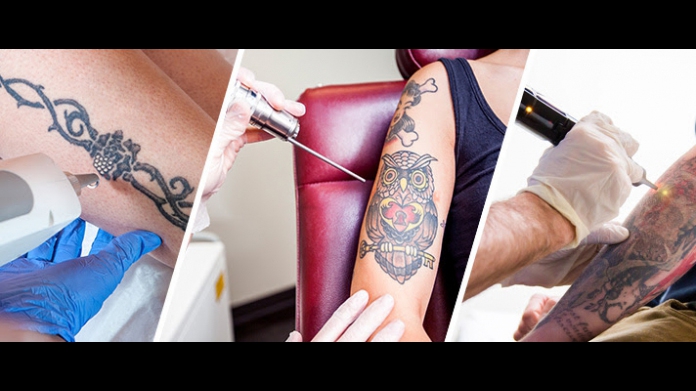That tattoo on your arm of a former flame—the one that seemed like a great idea years ago—is kind of embarrassing today. According to a Harris Interactive poll conducted in January 2012, 1 in 8 of American adults who have tattoos regret getting one. In addition, many people who get a tattoo will want to update or modify their tattoos.
The American Society for Dermatologic Surgery (ASDS) reports that in 2011, its doctors performed nearly 100,000 tattoo removal procedures, up from the 86,000 performed in 2010. And, from 2012 to 2013, the number of tattoo removals increased by 52 percent.
Unfortunately, removing a tattoo is not simple and it’s a painstaking process. Tattoos are created by using an electrically powered machine that moves a needle up and down to inject ink into the skin, penetrating the epidermis, or outer layer, and depositing a drop of ink into the dermis, the second layer of skin. The cells of the dermis are more stable compared with those of the epidermis, so the ink will mostly stay in place for a person’s lifetime.
Tattoo Removal Options & Results
- Lasers
There are several FDA-cleared devices intended for use in removing tattoos. One of the effective and safest ways to remove tattoos is through laser surgery. With laser removal, pulses of high-intensity laser energy pass through the epidermis and are selectively absorbed by the tattoo pigment. The laser breaks the pigment into smaller particles, which may be metabolized or excreted by the body, or transported to and stored in lymph nodes or other tissues, Kosoglu explains.
The type of laser used to remove a tattoo depends on the tattoo’s pigment colors. Due to every color of ink absorbs different wavelengths of light, multi-colored tattoos may require the use of multiple lasers. Lighter colors such as green, red, and yellow are the hardest colors to remove, while blue and black are the easiest.
Generally speaking, just one laser treatment won’t do the trick. According to the American Academy of Dermatology, the procedure requires multiple treatments (typically six to 10) depending on a tattoo’s size and colors, and requires a few weeks of healing time between procedures.
- Dermabrasion
Other methods include dermabrasion—actually “sanding” away the top layer of skin—and excision, cutting away the area of the tattoo and then sewing the skin back together.
- Other Methods for Tattoo Removal such as Removal Creams
At this time, FDA has not approved or cleared any do-it-yourself tattoo removal ointments and creams that you can buy online. The tattoo removal ointments and creams may cause unexpected reactions, such as rashes, burning, scarring, or changes in skin pigmentation in the process.
Pain and Side Effects of Laser Tattoo Removal
The pain of tattoo removal depends on a person’s pain threshold. Some people compare the sensation of laser removal to being spattered with drops of hot bacon grease or snapping a thin rubber band against the skin. A trained dermatologist will be able to adjust the treatment to the patient’s comfort level.
Some side effects may include pinpoint bleeding, redness, or soreness, none of which should last for long. Another possible side effect of tattoo removal is scarring.
These laser devices must be cleared for use by, or under the supervision of, a health care professional. The removal procedure requires using the correct type of laser, understanding the reaction of tissue to laser, and knowing how to treat the area after the procedure.
Source: www.fda.gov
Read also: Caution: Do Your BodyBuilding Products Contain Steroids?









